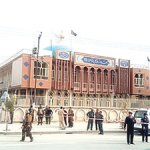
As Nigeria grapples with devastating floods that have displaced thousands and caused widespread damage, a university researcher is advocating for a proactive, technology-driven approach to disaster management.
Eniola Onatayo, a researcher at Bells University of Technology, Ota, argues that Nigeria’s traditional reactive response to floods must be replaced with predictive intelligence using readily available geospatial tools.
“Flooding is not just a natural event anymore—it’s a predictable emergency,” Onatayo stated in a recent interview. She explained that by using satellite imagery, terrain models, and rainfall data, authorities can identify communities at risk weeks before disaster strikes.
As part of her research, Onatayo has conducted flood risk assessments in Benue and Niger states, successfully demonstrating how free, open-source mapping software like QGIS can be used to model flood-prone zones. She stressed that these tools do not require expensive software or foreign consultants; what is needed is the political will and training to use them at the local level.
According to Onatayo, the primary obstacle is not the lack of technology but a gap in institutional capacity. Most emergency response agencies in Nigeria lack dedicated Geographic Information Systems (GIS) units, and there is poor coordination and data sharing among different government bodies.
“Many of these tools are free,” she explained. “You don’t need expensive software or foreign consultants. What we need is training and political will to use these tools at the local level.”
The technology gap, according to Onatayo, lies not in availability but in institutional capacity. Most emergency response agencies lack dedicated Geographic Information Systems (GIS) units, and coordination between data-collecting agencies remains poor.
However, traditional disaster management approaches face institutional hurdles. Onatayo noted that most emergency response agencies currently lack dedicated Geographic Information Systems (GIS) units, and coordination between data-collecting agencies remains fragmented.
“The technology exists and it’s accessible,” she explained. “The real challenge is building the institutional capacity to use these tools effectively at the local level.”
“Nigeria has the talent, the data, and the urgency,” Onatayo said. “What’s missing is the institutional framework that connects research with emergency response.”
Onatayo outlined a three-pronged approach for Nigerian authorities:
First, establish GIS units within federal and state emergency agencies, staffed with trained personnel who can interpret satellite data in real-time.
Second, create a national data-sharing policy that allows universities, meteorological agencies, and emergency responders to access the same geospatial information.
Third, build a centralized digital platform where different agencies can collaborate on risk mapping and early warning systems.
“Data must flow freely between collectors and users,” she emphasized. “Only then will our maps protect people in real-time.”
“Spatial intelligence is no longer optional,” she said. “It’s a survival tool, and Nigeria must start using it immediately.”
“Prevention costs far less than recovery,” Onatayo concluded. “Every naira invested in predictive mapping saves thousands in disaster response.”
State governments and emergency agencies seeking flood risk assessments can contact the Nigerian Meteorological Agency (NiMet) or reach out to university geoinformatics departments for technical support.
READ MORE FROM: NIGERIAN TRIBUNE
WATCH TOP VIDEOS FROM NIGERIAN TRIBUNE TV
- Let’s Talk About SELF-AWARENESS
- Is Your Confidence Mistaken for Pride? Let’s talk about it
- Is Etiquette About Perfection…Or Just Not Being Rude?
- Top Psychologist Reveal 3 Signs You’re Struggling With Imposter Syndrome
- Do You Pick Up Work-Related Calls at Midnight or Never? Let’s Talk About Boundaries






